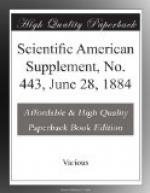SOME RELATIONS OF HEAT TO VOLTAIC AND THERMO-ELECTRIC ACTION OF METALS IN ELECTROLYTES.[1]
[Footnote 1: Read before the Royal Society, Nov., 1883.]
By G. GORE, F.R.S., LL.D.
The experiments described in this paper throw considerable light upon the real cause of the voltaic current. The results of them are contained in twenty tables; and by comparing them with each other, and also by means of additional experiments, the following general conclusions and chief facts were obtained.
When metals in liquids are heated, they are more frequently rendered positive than negative in the proportion of about 2.8 to 1.0; and while the proportion in weak solutions was about 2.29 to 1.0, in strong ones it was about 3.27 to 1.0, and this accords with their thermo-electric behavior as metals alone. The thermo-electric order of metals in liquids was, with nearly every solution, whether strong or weak, widely different from the thermo-electric order of the same metals alone. A conclusion previously arrived at was also confirmed, viz., that the liquids in which the hot metal was thermo-electro-positive in the largest proportion of cases were those containing highly electro-positive bases, such as the alkali metals. The thermo-electric effect of gradually heating a metal in a liquid was sometimes different from that of suddenly heating it, and was occasionally attended by a reversal of the current.
Degree of strength of liquid greatly affected the thermo-electric order of metals. Increase of strength usually and considerably increased the potential of metals thermo-electro-negative in liquids, and somewhat increased that of those positive in liquids.
The electric potential of metals, thermo-electro-positive in weak liquids, was usually about 3.87 times, and in strong ones 1.87 times, as great as of those which were negative. The potential of the strongest thermo-electric couple, viz., that of aluminum in weak solution of sodic phosphate, was 0.66 volt for 100 deg. F. difference of temperature, or about 100 times that of a bismuth and antimony couple.
Heating one of the metals, either the positive or negative, of a voltaic couple, usually increased their electric difference, making most metals more positive, and some more negative; while heating the second one also usually neutralized to a large extent the effect of heating the first one. The electrical effect of heating a voltaic couple is nearly wholly composed of the united effects of heating each of the two metals separately, but is not however exactly the same, because while in the former case the metals are dissimilar, and are heated to the same temperature, in the latter they are similar, but heated to different temperatures. Also, when heating a voltaic pair, the heat is applied to two metals, both of which are previously electro-polar by contact with each other as well as by contact with the liquid; but when heating one junction of a metal and liquid couple, the metal has not been previously rendered electro-polar by contact with a different one, and is therefore in a somewhat different state. When a voltaic combination, in which the positive metal is thermo-negative, and the negative one is thermo-positive, is heated, the electric potential of the couple diminishes, notwithstanding that the internal resistance is decreased.




